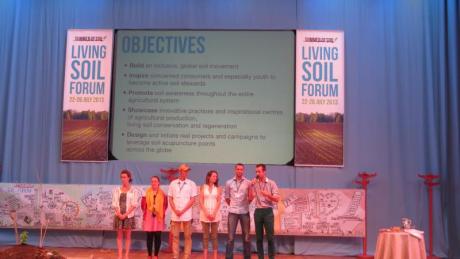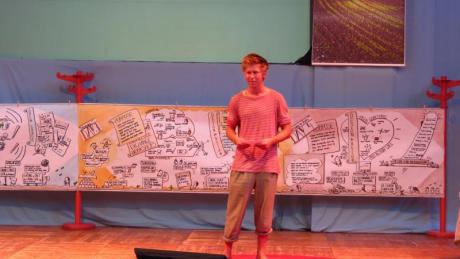The activities of the forum were basically finished already on the Thursday, and the last day was more a day of thanks and goodbyes, and of looking back at what’s been accomplished. The goal of the forum had been to create a global movement for living soils, and to give energy to some tangible projects that may continue into the future.
The first of these goal is of course more than ambitious, but as acknowledged in the final plenary, a sense of community has at the very least been built among many of the participants. Furthermore, there are tangible outcomes in form of the different projects that have been developed during the last days, either from scratch, or by further co-development of a participant’s existing project or ideas. (See project coordinator Pieter Ploeg giving his words on this in our brief interview below.)

Prominent projects of the forum
From the 13 projects that had been presented on Thursday, the organising team had selected 4 which were specially awarded for their potential (although the team emphasised that all were successes in their own right). I will also let these four stand as examples of what has been produced at the forum:
First awarded was an idea which was created during the forum and called by the young grassroots participant Cornelius Heimstädt (who also got to hold a personal and very appreciated speech on stage). This project, titled Soilidarity, is about creating a new volunteer organisation where young people can lend their skills and energy for hands-on work and joint learning with farmers in the semi-arid African Sahel. (For more on this initiative, read the Thursday blog by SIANI’s Anneli Sundin.)
Several project teams had been focusing on starting up new education programs, courses or training centres for soil and agriculture learning. Awarded for an outstanding implementation speed was the Allversity crowd-build course: Understanding soil. The first step for this free online course was taken about a month before the forum, though it was much accelerated through the forum days. By the end of the week, according to core organiser Shane McMillan, around 60-80% of course text material had already been written.
The Allversity course will go through three units: first explaining the basics of soil, soil types and how they are formed; then present current trends in soils and agriculture; and finally teach methods for regenerative farming and combating erosion and other problems. The team’s goal is to make the course available online around the middle of August. (So keep your eyes open for announcements at the Allversity website!)
Thirdly, the project on building a Global Network of Beacon Farms was prized for making good use of good examples. This idea was called by Patrick Holden on the Monday of the forum, and was further developed by other participants. The idea is to build a network of existing ‘best practice’ organic farms around the world, that can display and teach methods for rebuilding soil. As the BERAS implementation project is soon coming to an end and already has an existing network of 18 farms, they expressed a wish to collaborate, and the hope is that many more farms will join.
Finally, for taking ambitious steps on a large scale, the jury awarded John Liu’s undertaking to build Research, Training and Innovation Centres for Ecological Restoration (also described in my Wednesday blog). According to Liu, there are effective methods to restore unproductive lands, and there are funds available, but there is a lack of initiative and people who will transfer the skills. Hopefully, this work may be a few steps closer to completion from the ideas and connections built at the forum.

Final words
Although this forum has had a stronger focus on local systems and grassroots action than we had perhaps anticipated from the beginning, I hope our reporting has also brought you some good insights on the global scales and general issues of soil. For me, it has; and I have also been able to go into great discussions with some of the knowledgeable participants to learn about soil microbiology, water retention, soil nutrient discourses, and more. It’s been broad and sometimes a bit unfocused, but inspiring and though-provoking.
I will leave the last space of this blog to let project coordinator Pieter Ploeg give his own words about the forum outcomes. My thanks goes to all the organising teams for hosting a well coordinated and beautifully arranged event that has allowed our thoughts to focus directly on the topics.
Petter Nordqvist
SIANI